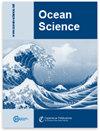Dimethyl sulfide cycling in the sea surface microlayer in the southwestern Pacific – Part 1: Enrichment potential determined using a novel sampler
IF 3.3
3区 地球科学
Q2 METEOROLOGY & ATMOSPHERIC SCIENCES
引用次数: 2
Abstract
Abstract. Elevated dimethyl sulfide (DMS) concentrations in the sea surface microlayer (SML) have been previously related to DMS air–sea flux anomalies in the southwestern Pacific. To further address this, DMS, its precursor dimethylsulfoniopropionate (DMSP), and ancillary variables were sampled in the SML and also subsurface water at 0.5 m depth (SSW) in different water masses east of New Zealand. Despite high phytoplankton biomass at some stations, the SML chlorophyll a enrichment factor (EF) was low (< 1.06), and DMSP was enriched at one station with DMSP EF ranging from 0.81 to 1.25. DMS in the SML was determined using a novel gas-permeable tube technique which measured consistently higher concentrations than with the traditional glass plate technique; however, significant DMS enrichment was present at only one station, with the EF ranging from 0.40 to 1.22. SML DMSP and DMS were influenced by phytoplankton community composition, with correlations with dinoflagellate and Gymnodinium biomass, respectively. DMSP and DMS concentrations were also correlated between the SML and SSW, with the difference in ratio attributable to greater DMS loss to the atmosphere from the SML. In the absence of significant enrichment, DMS in the SML did not influence DMS emissions, with the calculated air–sea DMS flux of 2.28 to 11.0 µmol m−2 d−1 consistent with climatological estimates for the region. These results confirm previous regional observations that DMS is associated with dinoflagellate abundance but indicate that additional factors are required to support significant enrichment in the SML.西南太平洋海面微层中的二甲基硫循环-第1部分:使用新型采样器确定富集潜力
摘要海表微层(SML)中二甲基硫化物(DMS)浓度升高与西南太平洋DMS海气通量异常有关。为了进一步解决这个问题,在新西兰东部的SML和0.5 m深度(SSW)的不同水团中采样了DMS,其前体二甲基磺酰丙酸盐(DMSP)和辅助变量。尽管部分站点浮游植物生物量较高,但SML叶绿素a富集因子(EF)较低(< 1.06),DMSP富集在一个站点,DMSP EF在0.81 ~ 1.25之间。SML中的DMS是用一种新型的透气性管技术测定的,该技术测量的浓度始终高于传统的玻璃板技术;然而,只有一个站点存在显著的DMS富集,EF范围为0.40 ~ 1.22。SML DMSP和DMS受浮游植物群落组成的影响,分别与鞭毛藻和裸子藻生物量相关。DMSP和DMS浓度在SML和SSW之间也存在相关性,其比值差异可归因于SML向大气中损失了更多的DMS。在没有显著富集的情况下,SML中的DMS不影响DMS排放,计算出的空气- seadms通量为2.28至11.0µmol m - 2 d - 1,与该地区的气候估计一致。这些结果证实了先前的区域观察,即DMS与鞭毛藻丰度有关,但表明需要其他因素来支持SML的显着富集。
本文章由计算机程序翻译,如有差异,请以英文原文为准。
求助全文
约1分钟内获得全文
求助全文
来源期刊

Ocean Science
地学-海洋学
CiteScore
5.90
自引率
6.20%
发文量
78
审稿时长
6-12 weeks
期刊介绍:
Ocean Science (OS) is a not-for-profit international open-access scientific journal dedicated to the publication and discussion of research articles, short communications, and review papers on all aspects of ocean science: experimental, theoretical, and laboratory. The primary objective is to publish a very high-quality scientific journal with free Internet-based access for researchers and other interested people throughout the world.
Electronic submission of articles is used to keep publication costs to a minimum. The costs will be covered by a moderate per-page charge paid by the authors. The peer-review process also makes use of the Internet. It includes an 8-week online discussion period with the original submitted manuscript and all comments. If accepted, the final revised paper will be published online.
Ocean Science covers the following fields: ocean physics (i.e. ocean structure, circulation, tides, and internal waves); ocean chemistry; biological oceanography; air–sea interactions; ocean models – physical, chemical, biological, and biochemical; coastal and shelf edge processes; paleooceanography.
 求助内容:
求助内容: 应助结果提醒方式:
应助结果提醒方式:


